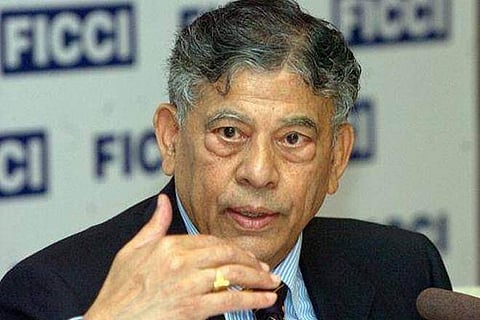

NEW DELHI: As the government gears up to find ways to earn more money from the nation-wide GST tax whose collections have been below par now for more than two years, experts are again raising questions on why a low single rate of GST was not introduced.
Former Finance Secretary Vijay Kelkar and economist Ajay Shah in their book, In Service of the Republic, have argued that a single GST rate of 10 per cent applied to 70 per cent of India’s produce would have earned the Centre and States 7 per cent of the country’s GDP and would have been easier to administer.
“A single 10 per cent rate applied on 70 per cent of the economy yields 7 per cent of GDP as tax revenues and even if we actually obtain a part of this, we are broadly okay,” Kelkar and Shah say in their book, adding “At this low rate it would have been able to possible to avoid all exclusions. Petroleum products could have gone in, real estate could have gone in.”
India currently has a multi-rate GST system with goods being taxed at 0, 5, 12, 18 and 28 per cent besides some goods such as petroleum products and liquor being left out of the GST set up. The complexity of the system and frequent changes are often blamed for poor collections. Till November-end, the total GST collections have been just over Rs 8 lakh crore, a shortfall of nearly rs 1 lakh crore against the target.
Kelkar and Shah argue that for sin goods such as tobacco and liquor, there could have been layers of non-Vatabale `sin taxes’ on top of basic GST imposed by states. States could also chose to impose carbon tax such as a tax on plastics used, layered on top of the GST.
With India turning into a near $ 3 trillion economy in 2019, a basic 10 per cent GST on 70 per cent of the economy would have translated into about $200 billion or Rs 14.4 lakh crore in GST revenues. Sin taxes on top of that on a select few articles could have got states some extra revenues.
May economists have argued in the past that a single low GST tax would have proven easier to administer and given a fillip to consumer demand as prices would have gone down, encouraging buyers to come to the marketplace. The former finance secretary and his co-author says “in the first two years significat resource allocation would have started taking place, with firms discovering more efficient ways of working, This would have fed back into higher GDP growth and thus tax revenues.”
Kelkar adds that “the Government at all levels is an important buyer of goods and services ad low rate would have generated a beneficial impact on the budget.”
However till now the NDA Government has taken a stand that multiple rates were best for the country. Famously, late finance minster Aru Jailtley had said “ a 'hawai chappal' (rubber slippers) and a Mercedes car cannot be taxed at the same rate.”
Other economists within the Government including Bibek Deb Roy, chairman of the PM’s Economic Advisory Council have argued for reducing the number of rates by merging some of them, something which the current finance ministry seems to be in favour of but by increasing the tax burden on some products.